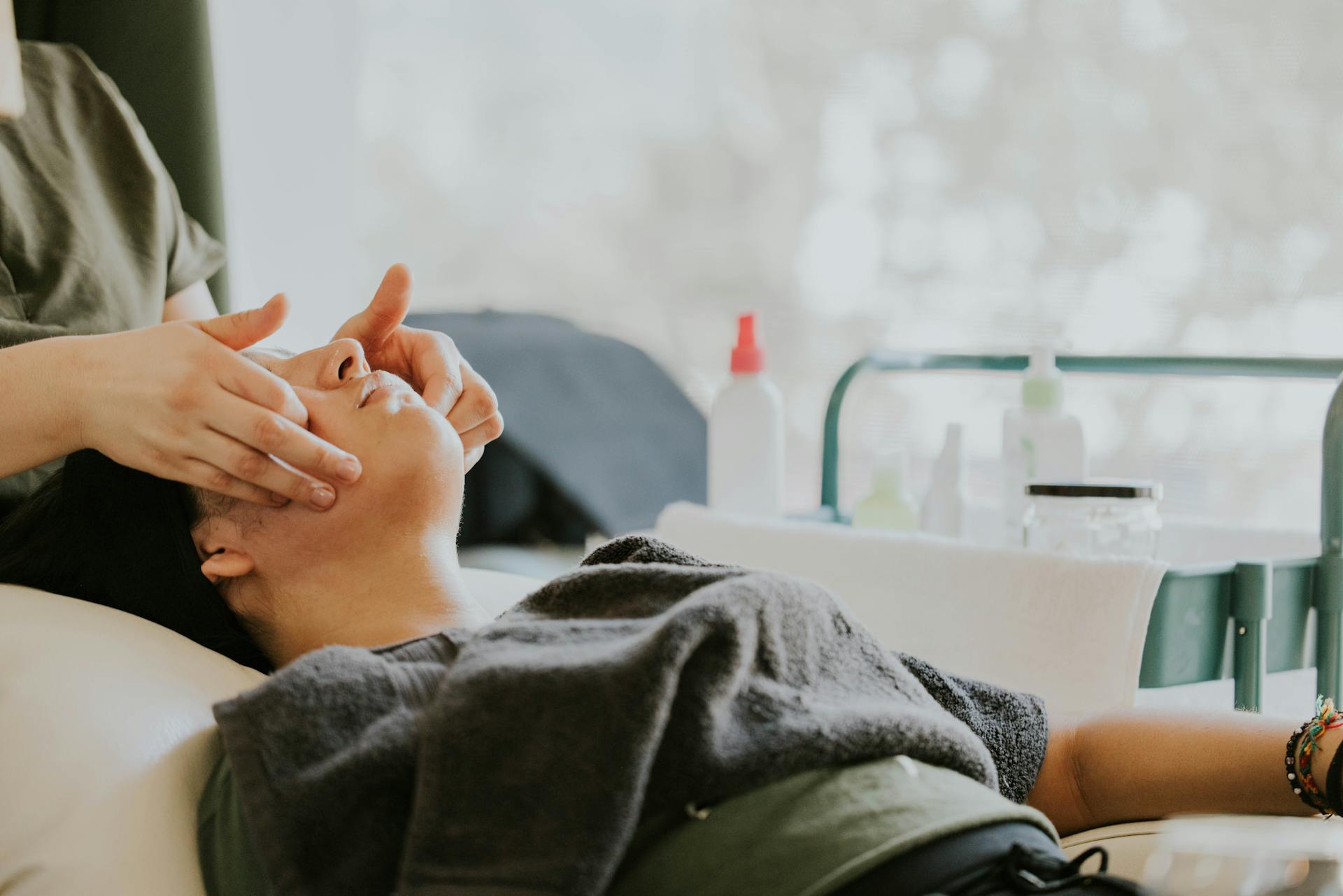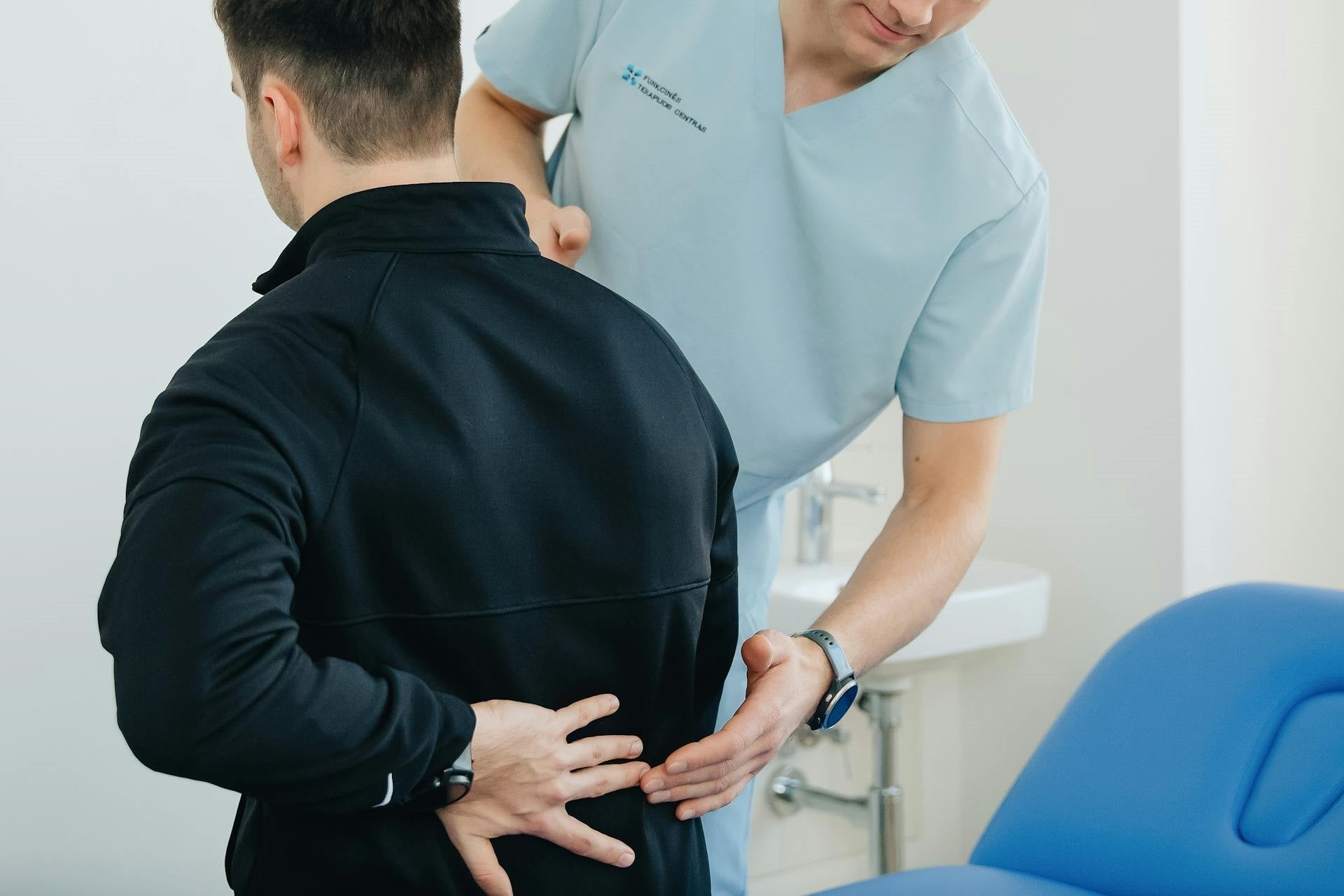Combien d'heures par jour passez-vous sur votre smartphone ? Si vous êtes comme la plupart des Américains, vous passez jusqu'à quatre heures et demie par jour penché sur votre écran. Si nous avons souvent de bonnes raisons d'être sur notre téléphone, l'inconvénient est que plier le cou à 45 degrés pour zoomer, faire défiler l'écran ou envoyer des SMS peut entraîner des douleurs dans le haut du corps, appelées « cou technologique ».
Si vous cherchez à soulager ces douleurs cervicales bien trop familières après un temps d'écran excessif, la bonne nouvelle est que le massage pourrait vous aider. Qu'il s'agisse de calmer les muscles surmenés ou de favoriser une meilleure posture, un massage rapide du cou peut apaiser les symptômes liés à la technologie, à court et à long terme.
Voici ce qu'il faut savoir sur le massage du cou technologique, y compris ses avantages et comment l'ajouter à votre routine quotidienne.
Qu'est-ce que le Tech Neck ?
À la base, le cou technologique (parfois appelé « cou textuel ») est un type de lésion due aux efforts répétitifs. Il survient suite à une posture courbée et avancée, qui force certains muscles et tendons à travailler davantage. Cela peut alors créer un cycle de tension chronique, et c'est en partie pourquoi 73 % des étudiants et 65 % des télétravailleurs déclarent souffrir de douleurs au cou ou au dos .
On pense souvent que le tech neck ne touche que le cou, mais il peut également affecter les épaules, la poitrine et les muscles du haut du dos. De plus, la fatigue musculaire et la pression nerveuse qui l'accompagnent peuvent provoquer des douleurs projetées dans d'autres zones, comme les mains ou les bras.
Si vous souffrez d'un cou technologique, vous pourriez remarquer des symptômes tels que :
- Douleurs sourdes et chroniques dans le cou, les épaules ou le haut du dos
- Symptômes semblables à des maux de tête
- Raideur ou manque de mobilité au niveau des épaules, de la poitrine ou du cou
- Épaules arrondies, dos voûté ou tête penchée en avant
Comment le massage peut-il aider le Tech Neck ?
Éviter la posture de la tête en avant et contrôler son temps d'écran sont quelques-unes des meilleures façons de lutter contre le cou technologique à la source. Mais si vous avez besoin d'un soulagement rapide après avoir passé trop de temps devant un écran, un massage peut être une option.
Plus précisément, il peut offrir des avantages tels que :
Apaiser les muscles fatigués et tendus
Lorsque vous remarquez une douleur au cou, un massage rapide peut apaiser les muscles qui ont surmené en raison d’une posture avancée.
Il s'agit notamment des muscles profonds de la colonne cervicale, qui peuvent s'affaiblir et se fatiguer à force de se pencher. De plus, il peut soulager les douleurs des muscles sous-occipitaux à la base du crâne, ainsi que ceux des omoplates et du thorax, qui peuvent être tendus à force de rester penché sur un écran.
Favoriser une meilleure posture
En plus de calmer les muscles stressés et tendus, le massage peut également aider à lutter contre le principal responsable des symptômes du cou technique : une mauvaise posture.
Comment ça marche ? En résumé, lorsque vous êtes constamment penché sur votre téléphone, vos muscles peuvent se bloquer dans des positions étirées ou contractées. Cela peut provoquer des douleurs , des points de déclenchement et des raideurs au niveau du cou et des épaules, tout en rendant plus difficile le maintien de l'alignement naturel du corps.
En utilisant un massage ciblé pour traiter cette raideur, il devient plus facile pour votre corps de revenir à sa posture naturelle et saine, atténuant ainsi les symptômes du cou technique.
Calmer les maux de tête
Les maux de tête sont l’un des symptômes les moins évoqués du cou technologique, mais vous serez peut-être surpris d’apprendre que votre mal de tête de fin de journée pourrait en fait être lié à la posture avancée qui accompagne trop de temps passé devant un écran.
Heureusement, un massage doux de la tête et du cou peut apporter un certain soulagement. Dans une étude de 2016 , des chercheurs ont comparé les effets du massage seul à ceux du massage associé à des techniques de manipulation sur les céphalées de tension.
Il est remarquable de constater que les deux interventions ont contribué à réduire les maux de tête, tandis que l’ajout de techniques de manipulation a apporté des avantages encore plus importants pour l’amplitude des mouvements du cou.
Quel est le meilleur type de massage pour le Tech Neck ?
Si vous envisagez d'utiliser régulièrement des massages pour gérer les douleurs cervicales liées à la technologie, voici quelques-uns des meilleurs types à connaître :
Libération myofasciale
Pour soulager les douleurs cervicales, de nombreux experts s'accordent à dire que le relâchement myofascial est l'un des meilleurs types de massage à essayer. Il utilise des étirements doux et une pression modérée pour détendre les muscles et les fascias. De plus, il est excellent pour libérer les points de déclenchement ou les nœuds, qui peuvent jouer un rôle majeur dans les douleurs cervicales et dorsales.
Les massothérapeutes professionnels sont souvent formés à la libération myofasciale. Si vous prévoyez de prendre rendez-vous pour un massage, n'hésitez pas à vous renseigner à ce sujet pendant votre séance. Voici quelques techniques utiles :
- Libération sous-occipitale , qui agit sur les petits muscles de soutien du cou près de la base du crâne
- Libération du trapèze supérieur , qui se concentre sur les grands muscles plats qui s'étendent du cou aux épaules
- Libération pectorale pour travailler les muscles de la poitrine, qui peuvent se contracter et se tendre en raison d'une mauvaise posture
Massage sportif
Si vos objectifs incluent une meilleure mécanique corporelle et la correction des déséquilibres, un massage sportif professionnel pourrait être la solution. Cette modalité combine généralement des techniques telles que le travail des tissus profonds, la libération myofasciale et même des étirements.
Vous pouvez essayer certaines techniques de massage sportif à domicile, comme le simple glissement ou le pétrissage autour des muscles endoloris et fatigués. Mais voici quelques méthodes spécifiques pour améliorer votre posture et soulager votre nuque :
- La compression consiste à appuyer votre main sur un muscle avec une pression modérée pour réchauffer et détendre le tissu.
- Libération des points gâchettes . Cela consiste à exercer une pression ferme sur des bandes de tissu tendues et irritantes (également appelées nœuds) pour les aider à se libérer.
- Massage par friction croisée, qui consiste à masser les fibres tendineuses et musculaires pour soulager la douleur et améliorer la mobilité.
Massage craniosacré
La thérapie craniosacrale (TCS) est une autre option de massage efficace pour le cou technique, notamment en cas de tensions musculaires ou de points gâchettes provoquant des maux de tête . En effet, elle cible presque exclusivement la tête, le cou et le dos.
Il utilise des techniques similaires à d'autres formes de massage, mais il peut être encore plus doux et ciblé pour le haut du corps. Les personnes qui optent pour le massage thérapeutique en groupe rapportent souvent des bienfaits tels que :
- Relaxation profonde et soulagement du stress
- Amélioration de la posture
- Meilleure amplitude de mouvement dans le haut du corps
Bien que la recherche en soit encore à ses débuts, une étude de 2019 a également révélé que la CST présentait des avantages prometteurs pour de nombreux types de douleurs chroniques, notamment les douleurs cervicales.
Comment essayer le massage cervical technologique : 3 méthodes

Un massage rapide du cou peut soulager les douleurs cervicales liées aux appareils électroniques en un clin d'œil, mais ce n'est pas la seule option d'auto-massage efficace. En réalité, une mauvaise posture peut affecter de nombreux muscles du haut du corps, et se concentrer sur chacun d'eux peut vous aider à trouver un soulagement encore plus grand.
Alors, pour une routine d’auto-massage complète qui cible le cou technique à un niveau plus profond, voici trois techniques à essayer :
1. Auto-massage pour les douleurs cervicales
Un massage cervical manuel peut paraître difficile, mais c'est l'un des moyens les plus simples de soulager les muscles du cou tendus et douloureux après une longue journée. Pour l'essayer :
- Commencez par vous asseoir avec une posture droite mais confortable.
- Prenez votre main droite et tirez doucement votre tête vers la droite jusqu'à ressentir un étirement du côté gauche de votre cou. Maintenez cette position pendant 10 à 20 secondes.
- Répétez avec le côté opposé.
- Ensuite, enroulez vos deux mains autour de votre nuque et effectuez trois compressions douces. Maintenez chaque compression pendant 2 à 3 secondes.
- Ensuite, massez votre nuque du centre vers l'extérieur avec vos doigts. Répétez l'opération sur toute la longueur du cou en exerçant une légère pression pendant 60 secondes.
- Utilisez vos doigts pour masser chaque côté de votre cou en effectuant de larges mouvements circulaires. Commencez par la base du crâne et descendez jusqu'aux trapèzes (situés entre les épaules et le cou). Ces grands muscles du dos sont souvent source de tensions et de points de déclenchement.
- Faites une pause et maintenez la pression sur les nœuds que vous trouvez pendant 5 à 10 secondes pour les aider à se libérer.
- Enfin, massez légèrement les muscles sous-occipitaux pendant 1 à 2 minutes supplémentaires. (Ces muscles se situent à la base du crâne, de chaque côté du cou.)
2. Déroulez la mousse
Un petit rouleau en mousse est idéal pour cibler les muscles du haut du dos, notamment les trapèzes et la coiffe des rotateurs . Il est également idéal pour détendre en douceur les petits muscles de la nuque.
Voici comment en utiliser un pour soulager le cou technique :
- Asseyez-vous sur le sol et placez votre rouleau en mousse horizontalement derrière vous.
- Allongez-vous doucement sur le dos, le rouleau étant placé sous le milieu du dos. Utilisez votre ceinture abdominale pour vous maintenir debout, presque comme si vous étiez en position assise.
- Rentrez légèrement votre menton et utilisez vos mains pour soutenir votre tête pour un soutien supplémentaire.
- En contractant votre tronc, penchez-vous doucement en arrière sur le rouleau en mousse. Votre cou et votre colonne vertébrale doivent se courber légèrement vers l'arrière (presque comme si vous étiez dans l'inverse de la posture classique du cou technique).
- Détendez-vous dans cette position pendant quelques secondes.
- Ensuite, utilisez la force de votre tronc pour vous relever jusqu’à la position de départ.
- Utilisez vos jambes pour soulever votre corps du sol.
- Commencez à faire rouler lentement les muscles du dos, du milieu vers le haut. Répétez l'exercice pendant 1 à 2 minutes.
- Vous pouvez également déplacer le rouleau en mousse vers le haut pour une libération myofasciale du cou. Alignez simplement la nuque avec le rouleau et faites pivoter lentement la tête d'un côté à l'autre pour masser les muscles.
3. Essayez un masseur cervical réparateur
Si l'auto-massage régulier fatigue vos mains - ou si vous cherchez simplement un moyen plus simple d'apaiser les tensions quotidiennes dues aux écrans et au stress - un appareil de massage du cou de soutien peut certainement valoir la peine d'être investi.
Une option mains libres à considérer est le masseur cervical MedMassager , un appareil compatible HSA/FSA conçu pour masser confortablement les muscles de la nuque pendant que vous vous détendez. De plus, il combine chaleur et douce oscillation bidirectionnelle pour reproduire la sensation d'un véritable massage cervical. Voici comment l'utiliser :
- Tournez le masseur à son réglage le plus bas.
- Placez-le confortablement derrière votre cou.
- Laissez les mouvements oscillants réchauffer doucement vos muscles.
- Après 60 secondes, augmentez l’intensité selon vos envies.
- Laissez vos muscles absorber le massage pendant 5 à 10 minutes, en ajustant la pression et la position du masseur selon vos besoins tout au long de votre séance.
Conseils pour de meilleurs résultats avec le massage technologique du cou
Que vous utilisiez un appareil de massage à domicile ou que vous optiez pour des techniques pratiques, voici quelques conseils pour vous aider à trouver le plus de soulagement possible :
- Combinez votre massage avec des étirements légers . Le massage est excellent pour soulager les douleurs musculaires, mais l'associer à de légers étirements du cou peut améliorer la souplesse et soulager les raideurs en profondeur.
- Utilisez-le pour rappeler à votre corps une posture saine. Lorsque vos muscles s'habituent à être courbés, ils ont tendance à s'y installer. Autrement dit, ils s'habituent à ce qu'ils font le plus souvent ; vous pourriez même vous retrouver à les maintenir dans des positions serrées ou inconfortables sans vous en rendre compte. Heureusement, le massage peut aider à détendre vos muscles et à les réaligner.
- Ajoutez de la chaleur. Combiner un massage avec un coussin chauffant ou une compresse chaude peut soulager la raideur tout en favorisant une bonne circulation sanguine.
- N'oubliez pas de masser les autres groupes musculaires qui peuvent finir par être surmenés en raison d'une mauvaise posture, comme ceux autour de la poitrine et des épaules.
Considérations
Un massage doux du cou ne présente généralement aucun danger. Cependant, comme pour toute thérapie naturelle, il est important d'obtenir l'accord de votre médecin avant de commencer, surtout si vous souffrez de problèmes de santé (ou de blessures) susceptibles d'en être affectés.
Par ailleurs, n'oubliez pas d'écouter votre corps. Le massage peut faire des merveilles sur les zones sensibles et les points gâchettes, mais il est préférable d'éviter les zones particulièrement douloureuses. De plus, il est toujours préférable de commencer par une pression douce et d'augmenter progressivement si nécessaire pour éviter de surcharger les muscles.
Autres conseils pour soulager le cou technologique
Le cou technologique est souvent considéré comme une affection unique, mais la vérité est qu'il s'agit plutôt d'un ensemble de douleurs qui se développent en raison d'habitudes quotidiennes.
La bonne nouvelle, c'est que , comme cela dépend de vos habitudes, de petits ajustements à votre mode de vie peuvent vous aider à soulager la douleur et à corriger les problèmes de posture au fil du temps. Voici quelques mesures à prendre :
Vérifiez vos habitudes technologiques
Travailler à un bureau (ou passer beaucoup de temps en ligne) peut mettre à rude épreuve votre cou et vos épaules. C'est particulièrement vrai si vous êtes constamment en train de vous pencher vers votre clavier, de vous pencher vers un écran d'ordinateur ou de regarder votre téléphone.
Dans cet esprit, voici quelques conseils techniques pour vous aider à réduire la tension sur votre cou et votre dos :
- Vérifiez que votre moniteur est à environ une longueur de bras.
- Assurez-vous que la hauteur de votre moniteur est proche du niveau des yeux.
- Si vous travaillez à un bureau, faites quelques pauses pour marcher et vous étirer tout au long de la journée.
- Maintenez votre téléphone plus haut pendant que vous faites défiler ou envoyez un SMS.
Essayez les exercices posturaux
Intégrer des étirements et des exercices du haut du corps à votre routine peut grandement contribuer à corriger les épaules voûtées et la posture avancée de la tête. Voici quelques bonnes options :
- Rétractions scapulaires . Elles consistent à serrer les omoplates l'une contre l'autre, ce qui peut aider à corriger une posture arrondie.
- Étirements des trapèzes pour soulager les tensions du haut du dos et de la nuque. (Vous pouvez essayer en vous asseyant dans une posture détendue et en inclinant simplement la tête de chaque côté.)
- Posture de yoga chat-vache , qui peut aider à mobiliser et à étirer les muscles du dos et du cou.
Le point sur le massage technologique du cou
À l'ère du téléphone, notre dos, notre cou et notre corps en souffrent souvent. Heureusement, la massothérapie peut vous aider à gérer les tensions et les douleurs liées à un temps d'écran excessif.
Il agit en apaisant la douleur, en brisant les points de déclenchement et en aidant les muscles à se détendre et à revenir à leurs positions naturelles, ce qui le rend utile si vous avez besoin d'un soulagement rapide de la douleur ou d'un soutien à long terme pour une meilleure posture et une meilleure mobilité.
Envie d'intégrer le massage du cou à votre routine quotidienne ? Les outils MedMassager peuvent vous aider. Procurez-vous le masseur de cou MedMassager dès aujourd'hui ou découvrez notre gamme complète d'outils maison fiables ici .



